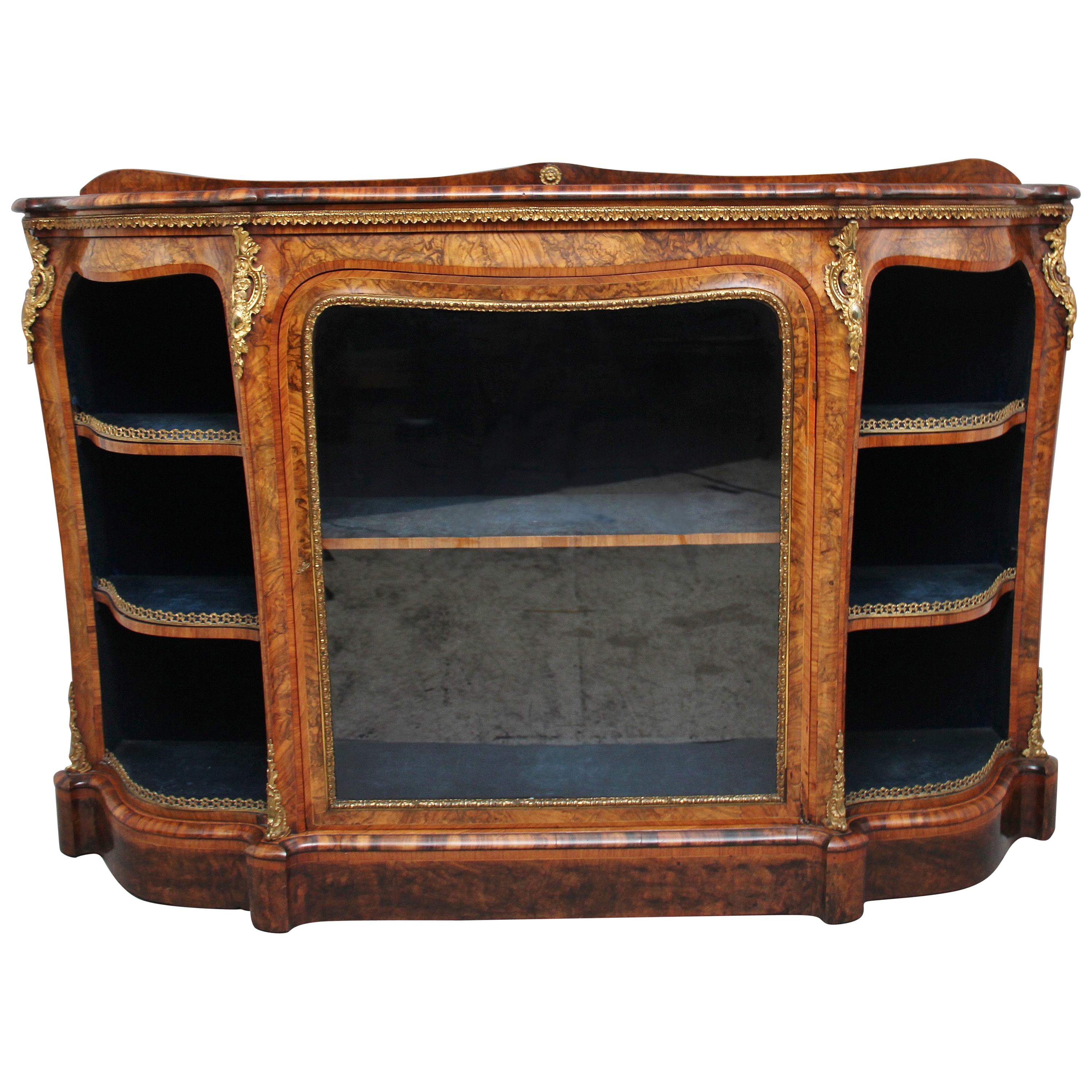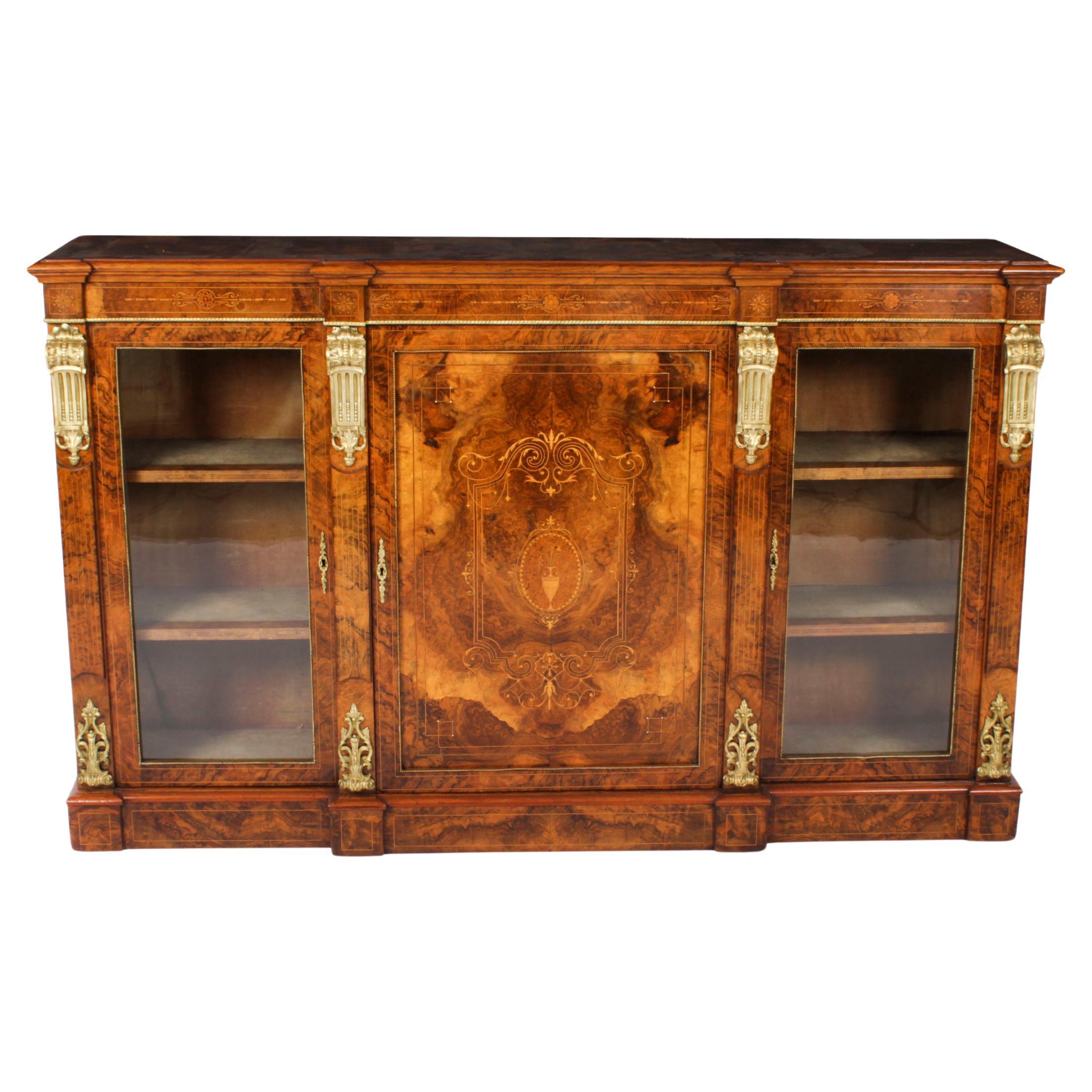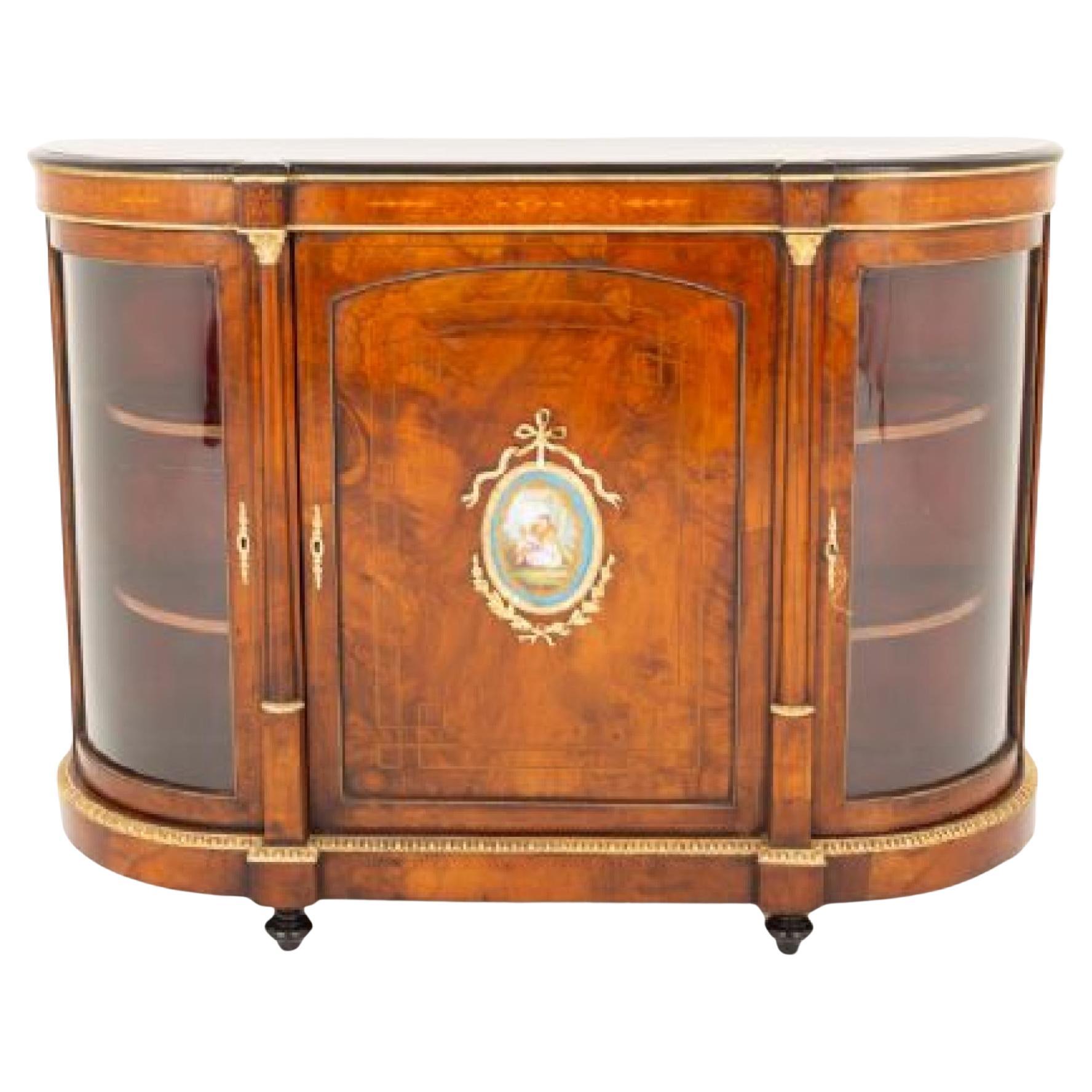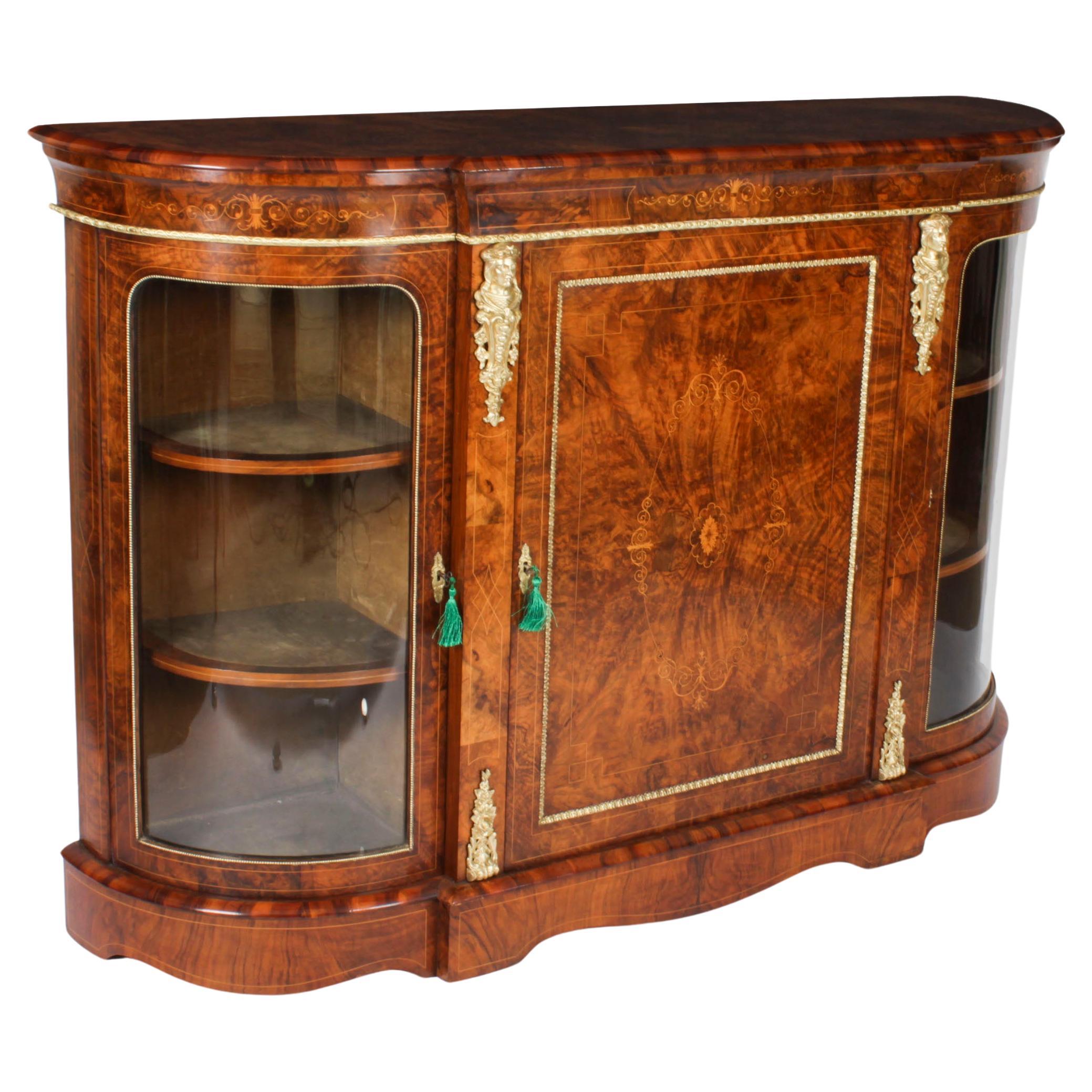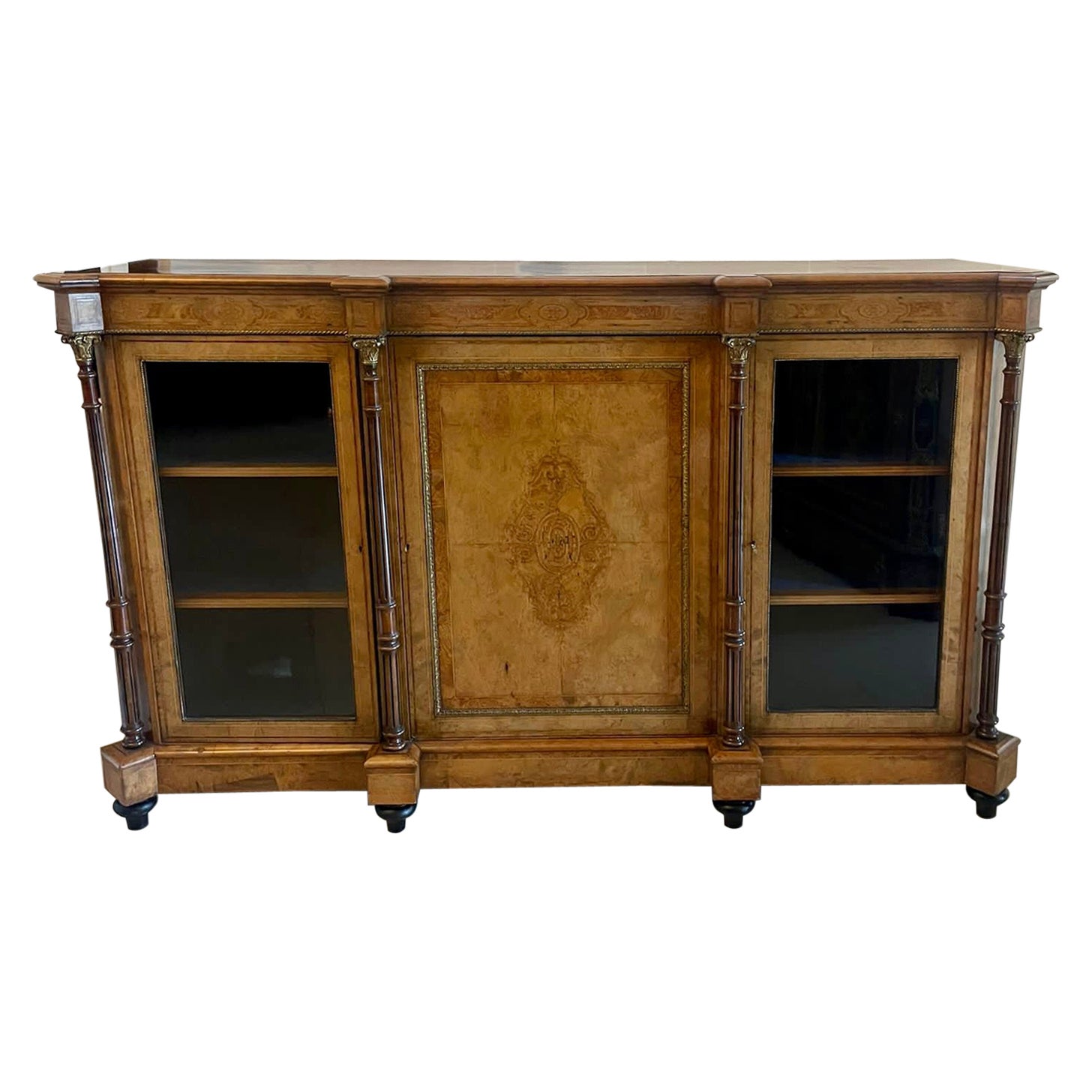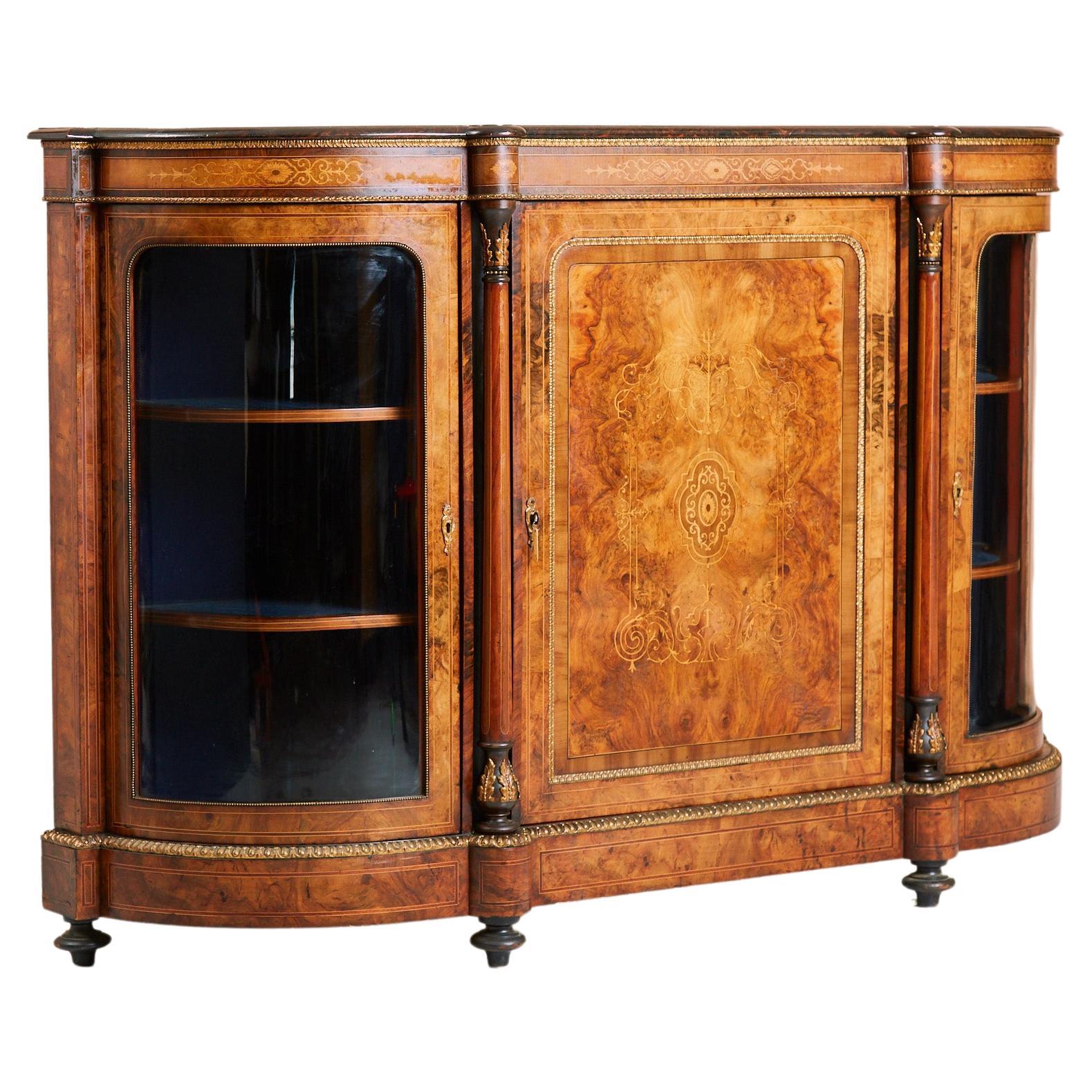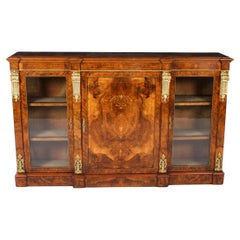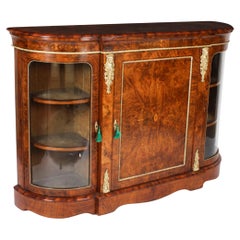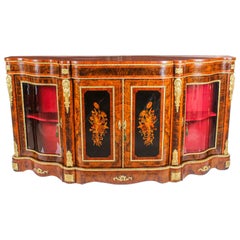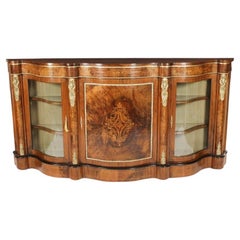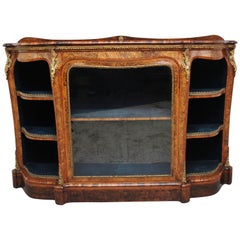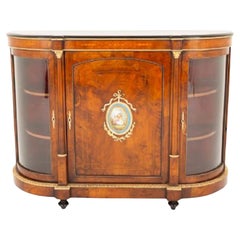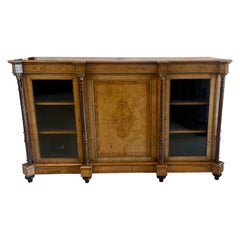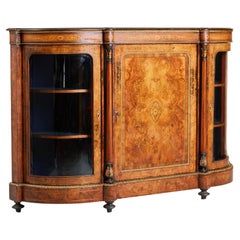Items Similar to Antique Victorian Burr Walnut Credenza Sèvres Plaques, 19th Century
Video Loading
Want more images or videos?
Request additional images or videos from the seller
1 of 21
Antique Victorian Burr Walnut Credenza Sèvres Plaques, 19th Century
$11,660.04
£8,500
€9,957.84
CA$16,377.09
A$18,029.96
CHF 9,215.15
MX$215,192.44
NOK 117,328.55
SEK 109,793.37
DKK 74,379.26
About the Item
This is a superb antique Victorian burr walnut and ebonized Sèvres Porcelain and ormolu-mounted line inlaid breakfront credenza, circa 1860 in date.
It has a striking central paneled door which is adorned with a beautiful ormolu-mounted and hand-painted Sèvres porcelain plaque depicting a courting couple with chaperone, flanked by an elegant glazed door on either side. There are three similar Sèvres porcelain plaques in the frieze, and it is further decorated with four Corinthian columns and exquisite ormolu mounts .
The glazed side doors open to reveal two shelves in each section, ideal for displaying your collectables, the central door opens to reveal a central shelf and plenty of storage space for drinks, glasses, crockery, etc,. The interior is lined in it's original violet velvet.
It is raised on ebonized bun feet and is complete with working locks and keys.
This is a stunning piece which is sure to attract a lot of attention.
Condition:
In excellent condition having been beautifully cleaned and polished, and the interior relined, in our workshops, please see photos for confirmation.
Dimensions in cm:
Height 119 x Width 190 x Depth 46
Dimensions in inches:
Height 46.9 x Width 74.8 x Depth 18.1
Burr walnut refers to the swirling figure present in nearly all walnut when cut and polished, and especially in the wood taken from the base of the tree where it joins the roots. However the true burr is a rare growth on the tree where hundreds of tiny branches have started to grow. Burr walnut produces some of the most complex and beautiful figuring you can find.
Sèvres Porcelain traces its roots in France to early craftsmen who had small manufacturing operations in such places as Lille, Rouen. St. Cloud, and most notably Chantilly. It is from Chantilly that a cadre of workers migrated to the Chateau de Vincennes near Paris to form a larger porcelain manufactory in 1738. French King Louis XV, perhaps inspired by his rumored relationship with mistress Madame de Pompadour, took an intense interest in porcelain and moved the operation in 1756 to even larger quarters in the Paris suburb of Sèvres. Sèvres was also conveniently near the home of Madame de Pompadour and the King's own Palace at Versailles.
From the outset the king's clear aim was to produce Sèvres Porcelain that surpassed the established Saxony works of Meissen and Dresden. Though the French lacked an ample supply of kaolin, a required ingredient for hard-paste porcelain (pate dure), their soft-paste porcelain (pate tendre) was fired at a lower temperature and was thus compatible with a wider variety of colors and glazes that in many cases were also richer and more vivid. Unglazed white Sèvres Porcelain "biscuit" figurines were also a great success. However, soft-paste Sèvres Porcelain was more easily broken. Therefore, early pieces of Sèvres Porcelain that remain intact have become rare indeed.
The Sèvres Porcelain manufactory always seemed to be in dire financial straits despite the incredibly fine works it produced. In fact, the king's insistence that only the finest items be created may have contributed to the difficulties. Only a limited number of European nobility could afford the extravagant prices demanded for such works. King Louis XV and eventually his heir, the ill-fated Louis XVI, were obliged to invest heavily in the enterprise. Ultimately, the Sèvres Porcelain Factory produced items under the name of "Royal" and thus the well-known Sèvres mark was born. King Louis XV even mandated laws that severely restricted other porcelain production in France so as to retain a near monopoly for his Sèvres Porcelain. The king even willingly became chief salesman for the finest of his products, hosting an annual New Year's Day showing for French nobility in his private quarters at Versailles. He eagerly circulated among potential buyers, pitching the merits of ownership and policing the occasional light-fingered guest.
Sèvres Porcelain may have indeed given the makers of Meissen and Dresden a run for their money by the end of the 18th century but for the French Revolution. By 1800, the Sèvres Porcelain Works were practically out of business due to the economic devastation of the new French Republic.
About the time when Napoleon Bonaparte named himself Emperor of France (1804), a new director was named for the Sèvres Porcelain Manufactory. Alexandre Brongniart, highly educated in many fields, resurrected Sèvres Porcelain. Soft-paste porcelain was eliminated altogether thanks to the earlier discovery of kaolin near Limoges. For four decades until his death, Brongniart presided over monumental progress for Sèvres Porcelain, catering not only to Napoleon himself, but at last to include the more financially profitable mid-priced market in the emerging middle class.
Ormolu (from French 'or moulu', signifying ground or pounded gold) is an 18th-century English term for applying finely ground, high-carat gold in a mercury amalgam to an object of bronze. The mercury is driven off in a kiln leaving behind a gold-colored veneer known as 'gilt bronze'.
The manufacture of true ormolu employs a process known as mercury-gilding or fire-gilding, in which a solution of nitrate of mercury is applied to a piece of copper, brass, or bronze, followed by the application of an amalgam of gold and mercury. The item was then exposed to extreme heat until the mercury burned off and the gold remained, adhered to the metal object.
No true ormolu was produced in France after, circa 1830 because legislation had outlawed the use of mercury. Therefore, other techniques were used instead but nothing surpasses the original mercury-firing ormolu method for sheer beauty and richness of color. Electroplating is the most common modern technique. Ormolu techniques are essentially the same as those used on silver, to produce silver-gilt (also known as vermeil).
- Dimensions:Height: 46.86 in (119 cm)Width: 74.81 in (190 cm)Depth: 18.12 in (46 cm)
- Style:Victorian (Of the Period)
- Materials and Techniques:
- Place of Origin:
- Period:
- Date of Manufacture:circa 1860
- Condition:
- Seller Location:London, GB
- Reference Number:Seller: 090771stDibs: LU950611683081
About the Seller
5.0
Platinum Seller
Premium sellers with a 4.7+ rating and 24-hour response times
Established in 1983
1stDibs seller since 2012
1,411 sales on 1stDibs
Typical response time: <1 hour
Associations
LAPADA - The Association of Arts & Antiques Dealers
- ShippingRetrieving quote...Shipping from: London, United Kingdom
- Return Policy
Authenticity Guarantee
In the unlikely event there’s an issue with an item’s authenticity, contact us within 1 year for a full refund. DetailsMoney-Back Guarantee
If your item is not as described, is damaged in transit, or does not arrive, contact us within 7 days for a full refund. Details24-Hour Cancellation
You have a 24-hour grace period in which to reconsider your purchase, with no questions asked.Vetted Professional Sellers
Our world-class sellers must adhere to strict standards for service and quality, maintaining the integrity of our listings.Price-Match Guarantee
If you find that a seller listed the same item for a lower price elsewhere, we’ll match it.Trusted Global Delivery
Our best-in-class carrier network provides specialized shipping options worldwide, including custom delivery.More From This Seller
View AllAntique Victorian Burr Walnut Credenza 19th Century
Located in London, GB
A superb antique Victorian burr walnut credenza, Circa 1860 in date.
Displaying sophistication and charm, this credenza is the ...
Category
Antique 1860s Victorian Credenzas
Materials
Walnut
Antique Victorian Burr Walnut Inlaid Ormolu Mounted Credenza 19th Century
Located in London, GB
This is a superb antique Victorian burr walnut inlaid and ormolu mounted credenza, circa 1860 in date
Oozing sophistication and charm, this credenza is the absolute epitome of Victo...
Category
Antique 1860s English Victorian Credenzas
Materials
Ormolu
Antique Victorian Burr Walnut and Marquetry Serpentine Credenza 19th Century
Located in London, GB
This is a superb antique Victorian ormolu mounted burr walnut and floral marquetry inlaid credenza, circa 1860 in date.
Oozing sophistication and charm, this credenza is the absolut...
Category
Antique 1860s English Victorian Credenzas
Materials
Ormolu
Antique Victorian Serpentine Burr Walnut Marquetry Credenza 19th Century
Located in London, GB
This is an exceptional quality antique Victorian ormolu mounted burr walnut and marquetry inlaid serpentine credenza, circa 1870 in date.
The entire piece highlights the unique and...
Category
Antique 19th Century English Victorian Credenzas
Materials
Ormolu
Victorian Burr Walnut Sevres Plaque Mirror Back Credenza Cabinet, 19th Century
Located in London, GB
This is a monumental fine and rare antique Victorian burr walnut and amboyna, Sevres porcelain and ormolu-mounted breakfront mirror backed credenza...
Category
Antique 1860s English Victorian Cabinets
Materials
Ormolu
Antique Burr Walnut Marquetry 3 Door Sideboard Early 20th Century
Located in London, GB
This is a superb antique burr walnut and marquetry breakfront sideboard, Circa 1920 in date.
It features three capacious drawers above three cupboards, each fitted with a central s...
Category
Vintage 1920s Sideboards
Materials
Walnut
You May Also Like
19th Century Burr Walnut Credenza
Located in Martlesham, GB
A fabulous quality 19th century burr walnut credenza, the shaped moulded top with satinwood crossbanding, above a gilt metal stiff leaf frieze and a central glazed and shaped cabinet...
Category
Antique 1860s British Early Victorian Cabinets
Materials
Walnut
$4,334 Sale Price
27% Off
Victorian Credenza Burr Walnut Cabinet Sevres Plaque 1860
Located in Potters Bar, GB
This Victorian credenza is raised upon ebonised turned feet
Circa 1860
Hand crafted from burr walnut with a lovely patina
The credenza having a central door featuring a Sevre style p...
Category
Antique 1860s Victorian Cabinets
Materials
Walnut
Outstanding Quality Antique Victorian Burr Walnut Inlaid Credenza/Sideboard
Located in Suffolk, GB
Outstanding quality antique Victorian burr walnut inlaid credenza having an outstanding quality burr walnut top above a quality burr walnut inlaid frieze, one large burr walnut door ...
Category
Antique 19th Century English Victorian Credenzas
Materials
Walnut
$9,821 Sale Price
20% Off
Superb Quality Victorian Inlaid Burr Walnut Credenza
Located in London, GB
Circa 1860, superb quality large Victorian inlaid burr walnut credenza.
The shaped top is in figured mirror-matched burr walnut with kingwood and boxwood inlay over an ormolu mount...
Category
Antique 19th Century British High Victorian Credenzas
Materials
Boxwood, Kingwood, Satinwood, Walnut
$4,049 Sale Price
46% Off
High Victorian inlaid burr walnut credenza with mirror
Located in Debenham, Suffolk
19th century Victorian inlaid and marquetry walnut credenza with mirror circa 1870.
We are pleased to offer this stunning 2 part credenza. Shaped...
Category
Antique Late 19th Century English High Victorian Sideboards
Materials
Ormolu
Fine Quality Victorian Burr Walnut and Ormolu Credenza/Sideboard
Located in Suffolk, GB
Fine quality Victorian burr walnut credenza with a fabulous quality serpentine shaped top and kingwood crossbanded frieze and beautiful ormolu mounts. The centre door has the original shaped mirror. It boasts wonderful serpentine open ends and stands on a shaped plinth base with pretty ormolu mounts.
This is a magnificent first-class piece beautifully crafted and designed...
Category
Antique 19th Century English Victorian Credenzas
Materials
Ormolu
More Ways To Browse
Mid Century Modern Metal Sideboards
Walnut Antique Sideboards Walnut Sideboards
White And Gold Sevres Porcelain
White Sevres
Sevres Marks
Antique Police
Antique Soft Paste
Soft Paste Antique Porcelain
Madame De Pompadour
Victorian Plaque
Used Crockery
Porcelain Couple
White Porcelain Figurine
Sevres Biscuit
Sevres Porcelain Cabinet
Antique White Porcelain Figurines
Biscuit Figurines
Sevres Figurine
